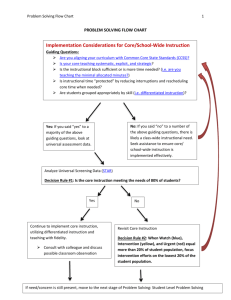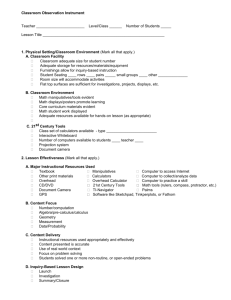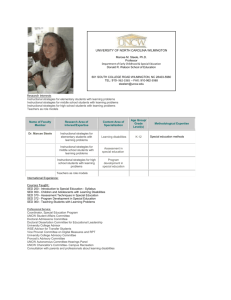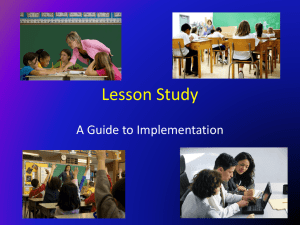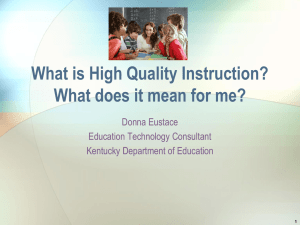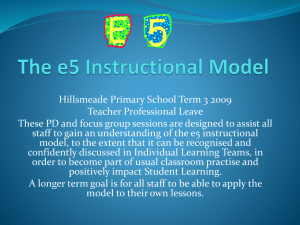Overview of Disabilities for Paraprofessionals
advertisement
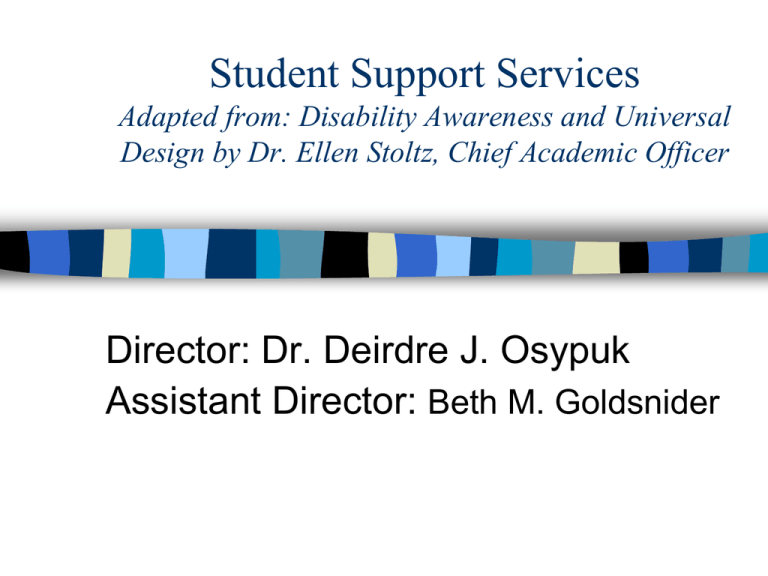
Student Support Services Adapted from: Disability Awareness and Universal Design by Dr. Ellen Stoltz, Chief Academic Officer Director: Dr. Deirdre J. Osypuk Assistant Director: Beth M. Goldsnider Who do we Supervise? Special Education Teachers School Psychologists Social Workers Guidance Counselors Speech Pathologists Nurses Occupational Therapist Physical Therapist Behavior Analyst Special Education Instructional Assistants Special Education Tutors Applied Behavior Analyst Assistants What District Wide Student Populations do we Serve? Special Education 504 Homeless English Language Learners B-3 Transitions Child Find What is our Department’s Mission? To provide the supports necessary for all students to be successful in the academic, social, emotional, and behavioral realms. To educate all students in the Least Restrictive Environment (LRE) to the maximum extent that is appropriate. Why do we Promote Inclusion? Develops tolerance for individual differences Positive academic and behavior role models Students with disabilities achieve at higher levels when educated with their non-disabled peers. Evidence to Support Inclusion Role of General Education Teacher Review and implement 504 Plans and Individual Education Plans (IEP) Actively participate in Planning and Placement Team (PPT) and 504 meetings Differentiate your instruction to meet the needs of all learners Modify lesson plans, tests/quizzes per IEP, 504 Plan Collaborate with special education teacher, related service staff Refer students to Special Education or 504 if they have not made progress during the 3rd tier of SRBI. Criteria for Special Education 1 of 14 educational disabilities Adverse impact on educational performance AND Disability requires specialized instruction Criteria for 504 Mental or physical impairment AND Impairment substantially impacts a major life activity Characteristics of Students with Learning Disabilities Achievement is above Instructional Strategies: average in some areas -pair verbal w/written and deficient in others directions despite average to -manipulatives above average -check-in/check-out cognitive ability -opportunities for independent Disorganized Short-term + Long-term practice memory deficits Characteristics of Students with Intellectual Disabilities Deficient intellect (IQ < 70) AND adaptive skills (< 78) Significant deficit in adaptive functioning (communication, social, self-help skills) across settings Socially: naïve; follower; easy target Flat profile academically with exception of rote skills Instructional Strategies: -direct instruction -repetition -concrete examples -relate to prior knowledge -manipulatives Characteristics of Students with Speech and Language Impairments Impaired articulation, expressive language, receptive language Limited vocabulary, simple grammar and sentences, unusual word order, slow speech, word retrieval difficulties; circumlocutions Instructional Strategies: - ask students to paraphrase directions - pair with peer language role Characteristics of Students with Other Health Impairments limited strength, vitality or alertness, including a heightened alertness with respect to the educational environment attention deficit with/without hyperactivity disorder, tuberculosis, rheumatic fever, nephritis, asthma, sickle cell anemia, hemophilia, epilepsy, lead poisoning, leukemia, or diabetes Strategy: Specific to impairment Characteristics of Students with ADD or ADHD ADD/ADHD -Not a skills deficit, but a performance deficit -Average to above average cognitive ability -Task dependent ADD-inattentive, lacks follow-through, difficulty following multi-step verbal directions, lacks organization ADHD-interrupts, blurts out answers, finishes assignments quickly but incompletely impulsive, hyperactive Instructional Strategies: -visual timer -preferential seating -step by step directions written out -frequent feedback -token reinforcement system -response cost -Differential Reinforcement of Incompatible -movement breaks Characteristics of Students with Autism Impaired pragmatic/functional language Restricted repertoire of activity and interests Impaired joint focus of attention Difficulty holding reciprocal social exchanges Difficulty understanding others emotions Instructional Strategies: - picture schedules - posted routines - advanced notice of change - social stories - Picture Exchange Communication Systems - Applied Behavior Analysis - Discrete Trial Instruction Characteristics of Students with Emotional Disturbance Typically average to above average cognitive ability Difficulty managing emotions, mood swings Anxious, depressed, fearful Difficulty building relationships with adults and peers Pervasive across settings and persons Instructional Strategies: -consistency -non-emotional response -present choices -extended time; -pair w/positive social, emotional peer models Characteristics of Oppositional Defiant Disorder Non-compliant Argumentative Weighs costs of behavior Instructional Strategies: -Precision Requests -do not negotiate -lay out consequences if chooses to behave vs misbehave -find carrot -Behavior Intervention Plans Precision Requests Variables that Affect Compliance




